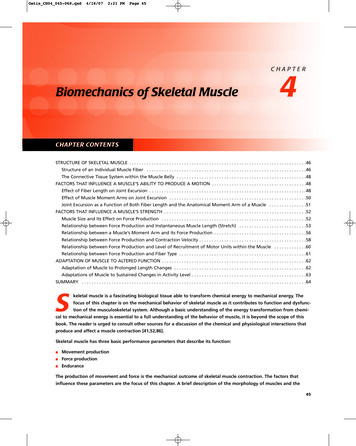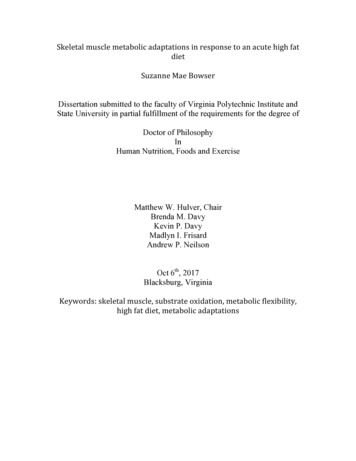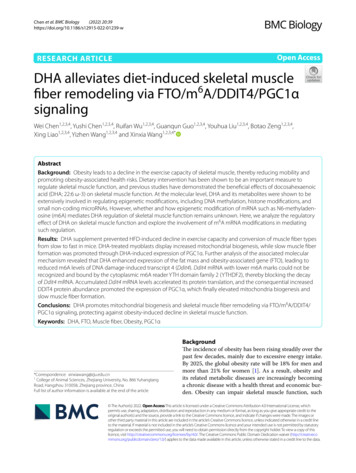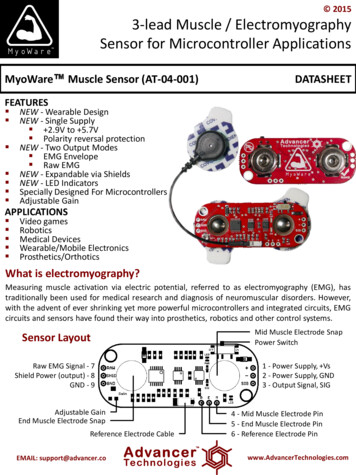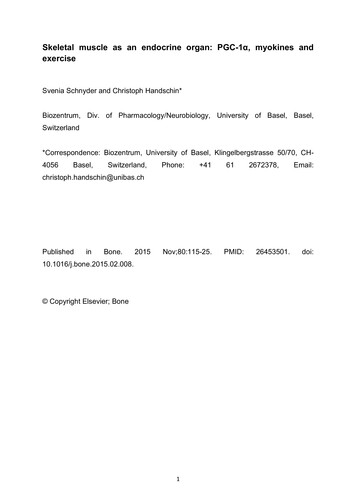
Transcription
Skeletal muscle as an endocrine organ: PGC-1α, myokines andexerciseSvenia Schnyder and Christoph Handschin*Biozentrum, Div. of Pharmacology/Neurobiology, University of Basel, Basel,Switzerland*Correspondence: Biozentrum, University of Basel, Klingelbergstrasse 50/70, CH4056Basel,Switzerland,Phone: .02.008. Copyright Elsevier; Bone1PMID:26453501.doi:
Reprint requestUnfortunately, due to copyright‐relatedt issues, we are not able to post the post‐print pdf version ofour manuscript ‐ in some cases, not even any version of our manuscript. Thus, if you would like torequest a post‐production, publisher pdf reprint, please click send an email with the request tochristoph‐dot‐handschin at unibas‐dot‐ch (see tion about the Open Access policy of different publishers/journals can be found on theSHERPA/ROMEO webpage: http://www.sherpa.ac.uk/romeo/Reprint AnfragenAufgrund fehlender Copyright‐Rechte ist es leider nicht möglich, dieses Manuskript in der finalenVersion, z.T. sogar in irgendeiner Form frei zugänglich zu machen. Anfragen für Reprints per Email anchristoph‐dot‐handschin at unibas‐dot‐ch (s. tionen zur Open Access Handhabung verschiedener Verlage/Journals sind auf derSHERPA/ROMEO Webpage verfügbar: http://www.sherpa.ac.uk/romeo/
Skeletal muscle as an endocrine organ: PGC-1α, myokines andexerciseSvenia Schnyder and Christoph Handschin*Biozentrum, Div. of Pharmacology/Neurobiology, University of Basel, Basel,Switzerland*Correspondence: Biozentrum, University of Basel, Klingelbergstrasse 50/70, unibas.ch2 41612672378,Email:
AbstractAn active lifestyle is crucial to maintain health into old age; inversely, sedentarinesshas been linked to an elevated risk for many chronic diseases. The discovery ofmyokines, hormones produced by skeletal muscle tissue, suggests the possibility thatthese might be molecular mediators of the whole body effects of exercise originatingfrom contracting muscle fibers. Even though less is known about the sedentary state,the lack of contraction-induced myokines or the production of a distinct set ofhormones in the inactive muscle could likewise contribute to pathologicalconsequences in this context. In this review, we try to summarize the most recentdevelopments in the study of muscle as an endocrine organ and speculate about thepotential impact on our understanding of exercise and sedentary physiology,respectively.3
Highlights- Besides its traditional functions, skeletal muscle has recently been discovered to bean endocrine organ- Myokines are signaling molecules with auto-, para- and/or endocrine functions thatare secreted from skeletal muscle cells- Myokines affect most organs and thereby provide a molecular explanation for thecross-talk between skeletal muscle and other tissuesKeywordsSkeletal muscle; exercise; myokines; inflammation; PGC-1αAbbreviationsAMPKAMP-dependent kinaseAP-1Activator protein 1aP2Adipocyte protein 2BAIBAβ-Aminoisobutyric acidBATBrown adipose tissueBDNFBrain-derived neurotrophic factorCaMKCalcium/calmodulin-dependent protein kinaseC/EBPαCCAAT-enhancer-binding protein αCnACalcineurin ACNTFCiliary neurotrophic factorCREBCyclic-AMP-responsive-element-binding proteinCXCR2CXC receptor 2ERRαEstrogen-related receptor αFGF21Fibroblast growth factor 21GLP-1Glucagon-like peptide-1GLUT4Glucose transporter 4HIF-1αHypoxia inducible factor 1α4
IGF-1Insulin-like growth factor 1ILInterleukinJAKJanus kinaseMEFMyocyte-enhancer factorMetrnlMeteorin-likeMSTNMyostatinNFATNuclear factor of activated T cellsNFκBNuclear factor κBNRF-1Nuclear respiratory factor 1OSMOncostatin-Mp38 MAPKp38 mitogen-activated protein kinasePGC-1αPeroxisome-proliferator activated receptor γ coactivator 1αPI3KPhosphatidylinositol 3-kinasePPARPeroxisome-proliferator activated receptorREEResting energy expenditureSERCAsarcoplasmic/endoplasmic reticulum calcium ATPaseSPARCSecreted protein acidic rich in cysteineSPP1Secreted phosphoprotein 1STATSignal transducer and activator of transcriptionTFAMMitochondrial transcription factor ATGF-βTransforming growth factor βTNFαTumor necrosis factor αUCPUncoupling proteinVEGFVascular endothelial growth factorVLDLVery low density lipoproteins5
1.1 Skeletal muscle morphology and functionThe human body consists of around 600 muscles that contribute to approximately40%-50% of the total body weight. Similar to cardiac muscle, skeletal muscle is astriated muscle, is attached to the skeleton and thereby facilitates the movement ofthe body by applying force to bones and joints. Skeletal muscle is composed ofmyofibers that are formed by the fusion of individual myoblasts during a processcalled myogenesis. Muscle plasticity, for example the adaptation to exercise, isfacilitated by a switch between oxidative, slow-twitch and glycolytic, fast-twitchmuscle fibers [1]. The former are characterized by a high mitochondrial number, richcapillary supply, slow twitch frequency and high resistance against fatigue. Theample vascularization and the abundance of heme-containing proteins confer a redcolor to muscle beds with a high proportion of oxidative fibers. On the other hand, lowmitochondrial number, fast twitch contraction kinetics, high peak force and lowendurance are the functional hallmarks of glycolytic muscle fibers. Muscle bedsconsisting of glycolytic fibers appear more whitish in color. In rodents, type I and typeIIa fibers are considered oxidative while type IIx and type IIb are more glycolytic. Inhumans, the spectrum of muscle fiber types is restricted to type I, IIa and IIx as wellas hybrid fibers [2].Myofibrils are composed of actin and myosin filaments arranged in sequentiallyrepeated units called sarcomeres, the basic functional units of a muscle fiber thatenables the muscle to contract. Skeletal muscle cells are the only voluntary type ofmuscle cells in contrast to cardiac muscle, smooth muscle and myoepithelial cells.Skeletal muscle cells are innervated by motor neurons and action potentials areexclusively initiated by the neurotransmitter acetylcholine in this context. Once amuscle cell is sufficiently depolarized, the sarcoplasmic reticulum releases calcium ina ryanodine receptor-dependent manner. Calcium subsequently binds to the troponinC subunit of the troponin complex. Troponin and tropomyosin are two importantregulatory proteins, which are associated with actin to prevent interaction with myosinin the rested state. Calcium-bound troponin C then undergoes a conformationalchange that leads to an allosteric modulation of tropomyosin, which subsequentlyallows myosin to bind to actin. ATP-dependent cross bridging between myosin andactin then leads to a shortening of the muscle. Finally, calcium is pumped back intothe sarcoplasmic reticulum by sarcoplasmic/endoplasmic reticulum calcium ATPases6
(SERCA) ultimately resulting in muscle fiber relaxation.It is important to note that muscle function is not limited to the generation of power,locomotion, posture and breathing. In fact, shivering skeletal muscle is the mostimportant organ for the maintenance of body temperature besides non-shiveringthermogenesis by brown adipose tissue. Furthermore, skeletal muscle is one of thelargest energy stores with substantial amounts of triglycerides and glycogen, inparticular in trained subjects. In addition, anaerobic glycolysis and breakdown ofskeletal muscle tissue during starvation releases lactate and amino acids,respectively, some of which subsequently are utilized to fuel hepatic (mainly alanineand lactate) and renal (mainly glutamine) gluconeogenesis. Thus, skeletal musclehas long been known to be capable of secreting factors in order to communicate withnon-muscle tissues. However, more recently, such auto-, para- and endocrinemediators produced and released by skeletal muscle have been termed “myokines”,in analogy to the adipokines produced by adipose tissue. These secreted factorspotentially have far-reaching effects on non-muscle tissue and thereby could providea molecular link between muscle function and whole body physiology. This review willmainly focus on the biology of a selection of such myokines.1.2. Skeletal muscle plasticityRepeated contractions, for example in training, result in a pleiotropic adaptation ofmuscle cells with a dramatic remodeling of contractile and metabolic properties.Importantly, the diametrically opposite activation pattern in endurance and resistancetraining elicit distinct cellular consequences. For example, endurance training resultsin a switch to oxidative, slow-twitch muscle fibers while resistance exercise increasesthe proportion as well as the cross-sectional area of glycolytic muscle fibers.Surprisingly, the molecular mediators of these adaptations are only poorlyunderstood [3]. It is clear that slow-type activation results in a more continuouselevation of intracellular calcium with low amplitude whereas these transients arecharacterized by more intermittent spikes with a high amplitude in glycolytic fibers inresistance training [4]. Nevertheless, it is unclear how the distinct calcium levels areinterpreted to result in either a slow- or a fast-type gene program. For example, inboth cases, the intracellular increase in calcium activates the catalytic subunit of the7
phosphatase calcineurin A (CnA) and members of the calcium/calmodulin-dependentprotein kinase family (CaMK) leading to a change in the phosphorylation status ofdifferent transcription factors and coactivators. These transcription factors include thecyclic-AMP-responsive-element-binding protein (CREB), myocyte-enhancer factor 2C(MEF2C) and MEF2D, and members of the nuclear factor of activated T cells (NFAT)family. In resistance-trained muscle, growth factor signaling, in particular that initiatedby the insulin-like growth factor 1 (IGF-1), seems to be an important modifier of theensuing muscle cell remodeling. In endurance-trained muscle, MEF2C/2D and NFATregulate the gene expression of slow-type genes. In addition, CREB, MEF2C/2D andNFAT control the transcriptional rate of the peroxisome-proliferator activated receptorγ coactivator 1α (PGC-1α) [5]. This transcriptional coactivator constitutes a regulatorynexus in the adaptation of skeletal muscle to endurance training [6, 7]. Accordingly, inaddition to the regulation by calcium signaling, PGC-1α gene expression andposttranslational modifications are affected by every major signaling pathway that isactivated in a contracting muscle fiber (Fig. 1). In turn, PGC-1α coordinates the entireprogram of endurance training adaptation in skeletal muscle. For example, PGC-1αis recruited to more than 7500 distinct sites in the mouse genome and induces andinhibits the transcription of around 984 and 727 genes, respectively, in muscle cells[8]. Such a complex transcriptional response is enabled by a specific interaction witha high number of transcription factor binding partners and furthermore, selectivemodulation of the PGC-1α activity by additional co-regulators, e.g. competition withthe corepressor NCoR1 for binding to the estrogen-related receptor α (ERRα) [9] inthe regulation of mitochondrial genes [10]. Thus, when overexpressed in muscle,transgenic mice exhibit a trained phenotype [11] while skeletal-muscle-specificknockout animals for PGC-1α suffer from a reduced endurance capacity as well asother signs of pathological inactivity [12, 13]. In individual exercise bouts, stabilizationof existing PGC-1α protein by the p38 mitogen-activated protein kinase (p38 AMPK)[15],otherposttranslational modifications and subsequent transcriptional induc
in analogy to the adipokines produced by adipose tissue. These secreted factors potentially have far-reaching effects on non-muscle tissue and thereby could provide a molecular link between muscle function and whole body physiology. This review will mainly focus on the biology of a selection of such myokines. 1.2. Skeletal muscle plasticity
